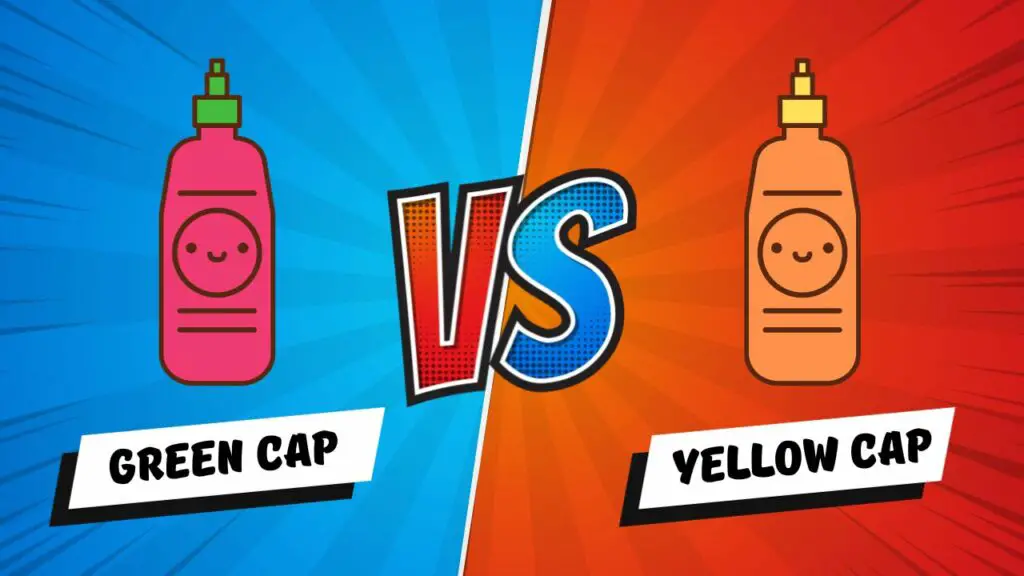In the realm of hot sauces, Sriracha holds a place of honor.
The spicy, tangy condiment is a favorite at barbecues, in noodle dishes, and atop eggs at breakfast tables around the world.
For most people, Sriracha is synonymous with the green-capped bottle produced by Huy Fong Foods. However, there is also another type of sriracha cap, “the yellow one”.
This article aims to compare these two variants by exploring their contents, taste, heat level, cost, uses in cooking, and substitutability.

What Is it and what does it contain? Green Sriracha vs Yellow Sriracha
Green cap Sriracha, predominantly produced by Huy Fong Foods, is the ubiquitous red sauce that most individuals associate with the name ‘Sriracha’.
This variant is made using a blend of sun-ripened red chilli peppers, sugar, salt, garlic and distilled vinegar. It’s widely recognized for its bold flavor and medium heat intensity.
On the other hand, Yellow cap Sriracha is produced by Three Mountains and made from yellow chillies.
The yellow chillies lend not only their color but also a distinct flavor profile to the sauce.
Besides these, ingredients include sugar, salt, garlic and vinegar – similar to its green-capped counterpart.
However, this yellow variation stands out with its tangy sweetness and lingering heat that leaves consumers craving for more.
Both these sauces are gluten-free and do not contain any artificial color or flavorings. Therefore, they are suitable for those following specific dietary requirements.
Which Taste Better: Green Sriracha vs Yellow Sriracha
The green cap Sriracha has an iconic, robust flavor that is tangy, spicy, and slightly sweet. This fiery red sauce offers a well-balanced blend of heat and flavor which appeals to a broad range of taste buds.
Yellow cap Sriracha, meanwhile, has a slightly milder heat profile.
With yellow chillies at its heart, this sauce delivers a unique combination of sweetness and tanginess followed by a lingering heat. This also makes it quite addictive to those who prefer their spice on the subtler side.
In terms of which tastes better – it really boils down to personal preferences. If you lean towards bold and intense flavors with higher heat levels, then green cap Sriracha could be your winner. But if you enjoy mild heat with nuanced flavor profiles, the yellow cap variant might suit your palate more.
Regardless of their differences in taste profile, both sauces offer a delightful kick and depth of flavor that can enhance any dish they are paired with.
How Hot Is It: Green Sriracha vs Yellow Sriracha
The heat level of a hot sauce is typically measured by Scoville Heat Units (SHUs), which quantify the concentration of capsaicin, the chemical compound that triggers a spicy sensation.
Huy Fong’s green cap Sriracha contains red jalapeños and registers at around 1,000-2,500 SHUs. This places it in the mild to medium range on the Scoville scale, providing a moderate level of heat that is balanced with its other flavors.
Yellow cap Sriracha from Three Mountains is made with yellow chillies, whose heat rating can significantly vary based on their type. On average though they are not as hot as red jalapenos, usually ranging from 100-1000 SHUs. This makes yellow cap Sriracha generally milder than its green counterpart.
Bear in mind that heat tolerance varies greatly among individuals. What may be considered mildly spicy to one person could be quite hot to another. So while it’s useful to know these measurements, personal taste testing remains the best way to judge the heat level of each sauce.
How Much Does It Cost: Green Sriracha vs Yellow Sriracha
The cost of Sriracha can vary based on factors such as the brand, the size of the bottle, and where you purchase it.
Green cap Sriracha by Huy Fong Foods is widely available in many supermarkets, grocery stores, and online platforms. It’s considered an affordable condiment with a 17-ounce bottle typically ranging from $3 to $5.
Yellow cap Sriracha from Three Mountains tends to be less prevalent on store shelves and may need to be sourced from specialty stores or online marketplaces. Its pricing can vary significantly depending on availability, but it typically costs slightly more than Huy Fong’s product due to its niche market position and unique flavor profile.
What Is It Used For: Green Sriracha vs Yellow Sriracha
Both green and yellow cap Sriracha sauces are incredibly versatile condiments that can be used in myriad ways to accentuate the flavor of your dishes.
Green cap Sriracha, with its robust red chilli flavor, is often used as a dipping sauce for spring rolls, sushi, or fried foods. It also pairs excellently with noodle dishes, stir-fries, pizzas, and even eggs. Some people also use it as a marinade for meat, or stir it into soups and stews for an extra kick of heat.
Yellow cap Sriracha offers a tangy sweetness with a milder heat that lingers, which makes it well-suited to lighter dishes. You might drizzle it over salads or seafood for an added zing. It’s also fantastic when mixed into dressings or aioli, used as a glaze for grilled vegetables or poultry, or combined with cream cheese for an easy yet flavorful spread.
Can I Substitute Green Sriracha For Yellow Sriracha? (And Vice Versa)
The answer to this question generally depends on the specific dish and your personal taste preferences.
Although both green and yellow cap Sriracha are hot sauces, they do have distinct flavor profiles. The green cap product has a stronger, more intense heat derived from red chilli peppers, while the yellow cap variant is milder with a unique sweetness from yellow chillies.
As such, if a recipe calls for green cap Sriracha but you only have yellow (or vice versa), you can make the substitution but should expect a different flavor outcome. This isn’t necessarily a bad thing; it just means your dish may have a slightly different taste or heat level than originally intended, although i dont think it’s going to be that big of a deal for most recipes.
In some recipes, particularly those where Sriracha is a major component of the flavor profile (like spicy noodle soups or stir-fries), you might want to stick as closely as possible to the specific type of Sriracha called for. In other uses, such as marinades or dressings where it’s one element among many, swapping one for the other might not make a significant difference.
At the end of the day, cooking should be about personal preference and experimentation – so feel free to try both types in various dishes and discover what works best for your palate!

